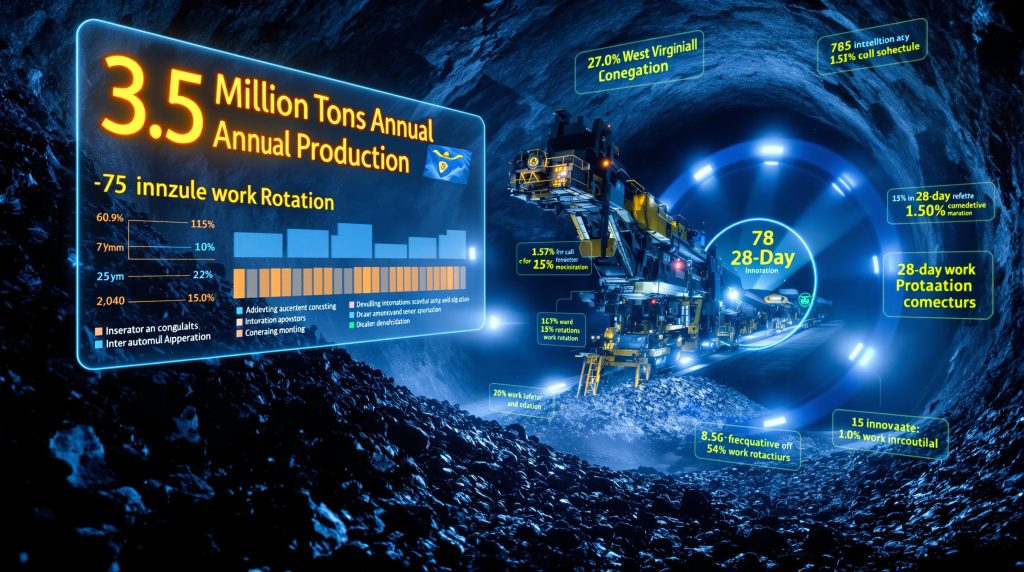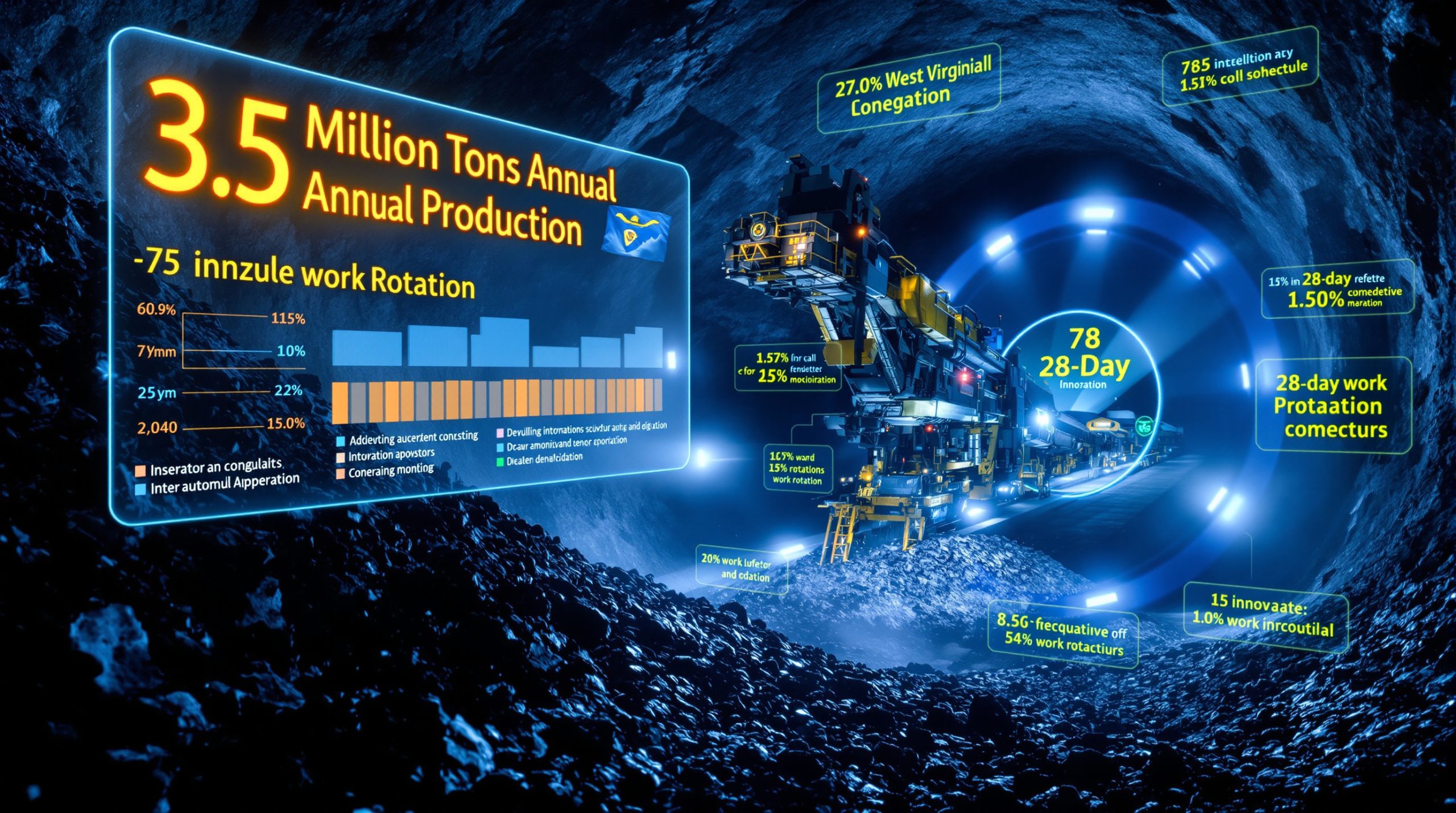Understanding Modern Longwall Mining Technology
Longwall mining represents one of the most sophisticated extraction methods in the coal industry, utilising advanced mechanised systems to achieve unprecedented efficiency rates. This technology involves the complete extraction of coal from rectangular panels using a shearer that moves continuously across the coal face, supported by hydraulic roof supports that advance as mining progresses. Furthermore, modern mine planning approaches enhance these systems' effectiveness.
Modern longwall systems demonstrate remarkable recovery rates, extracting 60-75% of available coal compared to traditional room-and-pillar methods that typically achieve only 40-50% recovery. According to the U.S. Energy Information Administration, these systems can produce 15,000-20,000 tons of coal daily, with longwall faces spanning 750 to 1,500 feet in width and extending up to 12,000 feet in length.
The technological sophistication of contemporary longwall equipment is evident in the specifications. Modern shearers weigh between 75-120 metric tons with cutting drums rotating at 25-50 RPM, while hydraulic shield support systems provide 500-1,000 tons of roof support capacity per unit. In addition, these systems incorporate automated horizon control using sensors to maintain optimal cutting height and adjust positioning in real-time, significantly reducing human intervention requirements.
Safety improvements through longwall technology have been substantial. The Mine Safety and Health Administration reports that longwall operations experience a 45% reduction in reportable injuries compared to room-and-pillar operations when controlling for production volumes. This improvement stems from reduced worker exposure to active mining faces and enhanced automation capabilities.
How Does Allegheny's $1 Billion Investment Transform Regional Mining?
The Allegheny Metallurgical longwall operation West Virginia investment exceeds $1 billion, representing one of the largest single mine investments in Appalachia over the past decade. This investment scale becomes significant when compared to West Virginia's total annual capital expenditures for underground coal mining operations, which averaged $450-600 million from 2019-2023.
Eric Lipinski, Chief Operating Officer at Allegheny Metallurgical, emphasised the comprehensive nature of this investment: "We have built a world-class team and facility here at Allegheny Met. The operation of the longwall reflects our investment in both advanced mining technology and our workforce."
The capital allocation encompasses several critical components:
• Advanced longwall equipment systems typically requiring $80-120 million for complete installation
• Supporting infrastructure development including ventilation systems and electrical distribution costing $30-50 million
• Coal preparation facilities capable of processing 2-4 million tons annually, requiring $150-250 million investment
• Rail loadout infrastructure with unit train capacity demanding $25-40 million
This investment transforms regional mining by introducing automation technologies that reduce operational costs while improving safety protocols. Consequently, the scale of investment demonstrates long-term confidence in metallurgical coal markets and establishes new technological benchmarks for Appalachian mining operations. The industry evolution trends support such substantial investments in advanced technology.
What Are the Economic Implications of 3.5 Million Tons Annual Production?
The Allegheny Metallurgical longwall operation's projected 3.5 million metric tons of annual metallurgical coal production positions it among the region's most significant operations. This production volume represents approximately 7.4% of West Virginia's total underground coal production capacity, which totalled 52 million short tons in 2023.
| Production Metric | Allegheny Metallurgical | West Virginia Average |
|---|---|---|
| Annual Output | 3.5 million metric tons | 2.1 million tons (typical mine) |
| Employment Capacity | 500+ positions | 187 workers (state average) |
| Production Scale | 7.4% of state capacity | Individual mine impact |
| Investment Level | $1+ billion | $450-600M (annual state total) |
The revenue implications are substantial given current metallurgical coal pricing. With metallurgical coal prices averaging $180-250 per short ton FOB mine during 2023-2024, the operation's annual revenue potential ranges from $700 million to $966 million at full capacity.
Metallurgical coal quality requirements for steel production include specific parameters:
• Volatile matter content: 15-30%
• Ash content: Less than 10% for premium grades
• Sulphur content: Below 1%
• Coking properties: Suitable for blast furnace applications
The Lower Kittanning seam accessed by Allegheny's operation typically produces low-to-medium volatile metallurgical coal with favourable coking characteristics. For instance, this positioning provides advantages in global markets where seaborne metallurgical coal trade totalled approximately 340 million tonnes in 2023.
How Does the Employment Structure Benefit West Virginia Workers?
The Allegheny Metallurgical operation introduces an innovative 28-day rotation schedule where employees work 14 consecutive days followed by 14 days off. This scheduling approach differs significantly from traditional Appalachian mining schedules that typically operate on 5-day or 6-day weekly rotations with 8-12 hour shifts.
Current employment stands at more than 400 individuals, expanding to over 500 workers at full operational capacity. This employment level represents 2.7 times the West Virginia underground mine average of 187 workers, reflecting the operation's scale and technological sophistication. Moreover, data‑driven operations enable better workforce management and scheduling optimisation.
The extended rotation system offers several advantages:
• Enhanced work-life balance through consecutive 14-day rest periods
• Reduced cumulative fatigue compared to traditional weekly schedules
• Educational opportunities during extended time-off periods
• Improved retention rates through schedule flexibility
Research by the National Institute for Occupational Safety and Health indicates that extended work rotations followed by extended rest periods can reduce cumulative fatigue when adequate daily rest is maintained during work periods. This scheduling innovation addresses industry-wide challenges of worker retention and fatigue management.
With average hourly wages for West Virginia underground coal miners at $33.47 in 2024, the operation provides access to above-average compensation. Furthermore, mining represents one of the highest-paying industrial sectors in a region where employment opportunities remain vital for economic stability.
What Role Does Geographic Location Play in Operational Success?
The Allegheny Metallurgical longwall operation's location near Volga, West Virginia in Barbour County provides strategic advantages for metallurgical coal production and distribution. This north-central West Virginia location sits approximately 20 miles south of Morgantown, positioning the operation within an established mining region with supporting infrastructure.
The geological advantages are significant. The Lower Kittanning seam represents one of the most widely mined coal seams in the Appalachian Basin, typically occurring at depths of 300-1,500 feet in northern West Virginia. This seam varies in thickness from 24 to 84 inches, with the Allegheny operation accessing areas with 75-inch height, providing optimal mining conditions for longwall extraction.
Transportation infrastructure connectivity enhances operational viability:
• CSX Transportation network access with connections to domestic steel mills
• Eastern export terminal connections for international markets
• 2,300 miles of operational railroad track throughout West Virginia
• Reduced unit train assembly costs through proximity to main rail lines
Rail transportation economics significantly impact delivered coal costs, typically accounting for 20-35% of total delivered costs for Appalachian mines serving distant markets. The operation's strategic location minimises these transportation expenses while maximising delivery flexibility.
The Lower Kittanning seam's geological characteristics as part of the Pennsylvanian Allegheny Group provide consistent coal quality parameters essential for metallurgical applications. Barbour County and surrounding areas have historically produced significant volumes of metallurgical coal due to favourable geological conditions and established mining infrastructure.
What Are the Environmental and Safety Considerations?
Modern longwall mining operations like Allegheny's implement comprehensive environmental and safety protocols that exceed traditional mining standards. Underground coal mining injury rates in the United States averaged 3.55 per 200,000 hours worked in 2023, with West Virginia specifically reporting 3.72 injuries per 200,000 hours.
Environmental compliance requirements for West Virginia underground operations include:
• Federal Surface Mining Control and Reclamation Act (SMCRA) compliance
• Clean Water Act NPDES permits for mine water discharge management
• Clean Air Act emission standards adherence
• West Virginia Water Pollution Control Act requirements
Water management systems address specific underground mining challenges:
Treatment Requirements:
- Total suspended solids removal
- pH adjustment for acidic mine drainage
- Iron and manganese extraction
- Sulphate reduction processes
Treatment Technologies:
- Settling pond systems
- Chemical treatment facilities
- Constructed wetland applications
- Real-time monitoring systems
Federal regulations mandate continuous methane monitoring at multiple underground locations, with automatic equipment de-energisation when methane concentrations exceed 1.0%. Advanced ventilation systems ensure adequate air circulation throughout longwall panels, maintaining safe working conditions while optimising production efficiency.
However, the longwall method's controlled roof collapse behind hydraulic supports minimises surface subsidence compared to other extraction methods, reducing environmental impact on surface land uses and water resources. Additionally, mine reclamation insights demonstrate how modern operations address long-term environmental stewardship.
How Does This Operation Compare to Other Appalachian Mines?
The Allegheny Metallurgical longwall operation West Virginia establishes new benchmarks for Appalachian coal mining through its scale, technology integration, and operational efficiency. The $1 billion investment exceeds typical regional mining investments by substantial margins, positioning it among the most significant mining developments in recent Appalachian history.
Comparative Production Analysis:
| Operational Metric | Allegheny Metallurgical | Regional Average |
|---|---|---|
| Daily Production Capacity | 9,600+ tons | 5,700 tons |
| Annual Output | 3.5 million metric tons | 1.5-2.1 million tons |
| Workforce Size | 500+ employees | 187 employees |
| Technology Investment | State-of-the-art longwall | Mixed traditional methods |
The operation's technological sophistication distinguishes it from conventional Appalachian mines that predominantly utilise room-and-pillar extraction methods. While room-and-pillar mining achieves 40-50% coal recovery, longwall operations extract 60-75% of available reserves, significantly improving resource utilisation efficiency.
Regional Economic Impact
The operation generates substantial tax revenue for local and state governments while creating indirect employment through supplier and service networks. The economic multiplier effect extends beyond direct mining employment, supporting equipment suppliers, transportation services, and local businesses throughout the region.
Employment practices also differentiate Allegheny's operation. The innovative 14-on/14-off scheduling contrasts with traditional weekly rotations used by most regional mines, potentially improving worker retention rates and operational stability compared to industry standards where turnover remains a persistent challenge.
What Are the Future Prospects for Metallurgical Coal Demand?
Global metallurgical coal market dynamics present both opportunities and challenges for operations like Allegheny Metallurgical. Seaborne metallurgical coal trade totalled approximately 340 million tonnes in 2023, with U.S. exports contributing 39.2 million short tons primarily to European, Brazilian, and Asian markets.
Demand Drivers:
• Infrastructure development projects in emerging economies driving steel demand
• Replacement cycles for aging steel production facilities requiring metallurgical coal
• Quality premiums for low-ash, low-sulphur metallurgical coal products
• Supply chain reliability preferences following global disruptions
Market Positioning Strategies
The operation's strategic advantages include consistent coal quality from the Lower Kittanning seam, reliable transportation infrastructure, and production scale enabling long-term contract negotiations. Customer diversification between domestic steel producers and export markets provides revenue stability and risk mitigation.
Technology Integration Impact
Steel manufacturing advances continue evolving, but metallurgical coal remains essential for blast furnace operations producing approximately 70% of global steel output. While electric arc furnace technology grows, it primarily utilises scrap steel inputs rather than replacing metallurgical coal demand for primary steel production.
Price Volatility Management
The operation's scale enables sophisticated pricing strategies including long-term contracts, spot market participation, and potential hedging arrangements. This flexibility provides revenue stability while capturing market opportunities during price cycles. Furthermore, capital raising strategies support operational financing requirements during market fluctuations.
Key Takeaways: Allegheny's Strategic Position in Modern Mining
The Allegheny Metallurgical longwall operation West Virginia represents a transformative investment in Appalachian coal mining, establishing new standards for technological integration, operational efficiency, and workforce development. The $1 billion investment commitment demonstrates confidence in long-term metallurgical coal markets while creating substantial economic benefits for West Virginia.
Operational Excellence Indicators:
• Production Leadership: 3.5 million metric tons annually positions operation among regional leaders
• Employment Impact: 500+ jobs provide significant economic contribution to local communities
• Technology Advancement: State-of-the-art longwall systems ensure competitive operational efficiency
• Market Position: Strategic location and quality product enable domestic and export market access
Success Factor Integration
The operation combines favourable geological conditions of the Lower Kittanning seam with advanced extraction technology, innovative employment practices, and strategic geographic positioning. This integration creates competitive advantages that extend beyond individual operational metrics to encompass comprehensive mining excellence.
Industry Impact
The successful deployment of advanced longwall technology in West Virginia demonstrates the continued viability of coal mining investment when supported by appropriate technology, workforce development, and market positioning. The operation serves as a model for modernising Appalachian mining operations while maintaining economic competitiveness. According to recent mining industry analysis, such investments secure long-term employment opportunities in traditional mining regions.
Future Considerations
Long-term success depends on continued global demand for metallurgical coal, operational efficiency maintenance, and adaptation to evolving environmental and safety regulations. The substantial initial investment provides a foundation for sustained operations while contributing to regional economic stability and energy security objectives.
For readers interested in comprehensive analysis of modern longwall mining operations and Appalachian coal industry developments, additional technical resources are available through mining engineering publications and industry research organisations specialising in coal extraction technologies and market analysis.
Looking to Capitalise on Mining Investment Opportunities?
Discovery Alert's proprietary Discovery IQ model delivers real-time alerts on significant ASX mineral discoveries, instantly empowering subscribers to identify actionable opportunities ahead of the broader market. Understand why major mineral discoveries can lead to substantial market returns by exploring Discovery Alert's dedicated discoveries page, showcasing historic examples of exceptional outcomes like De Grey Mining and WA1 Resources.




